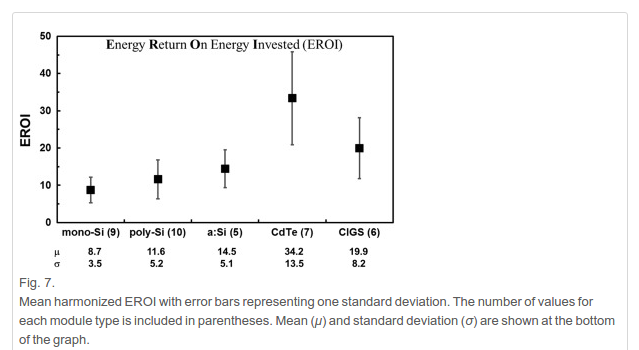Do not apply Moore's law. It's a false analogy. Moore's law is a consequence of miniaturization where putting more transistors in the same space yields greater speed, lower cost, and less power use. Integrated circuits now run a few billion cycles per second. ENIAC (tubes) ran at 5kHz, so a modern CPU is about a million times faster.
Solar cells where invented around the same time ... but the important factor here is conversion efficiency which has only about doubled, so only a factor two.
https://en.wikipedia.org/wiki/Solar_cel ... 60812).jpg
The dollar cost improvements you see here is from increasing the scale of production facilities. Subsidies provide a lot of boost for this. So solar power is falling in price because people are building larger factories ... not because they're making large advances in physics...
EROEI calculations are really hard to make. You can find them discussed around on the forum. You have to track all inputs all the way around the system and allow it to bootstrap itself to avoid given a less powerful energy source some unintended help from a more powerful one. Since there's no society that operates completely on one kind of energy source, the numerics quickly gets "polluted". A lazy way to do a calculation is to track dollar figures, but that ignores subsidies and market forces, and it largely compares apples and oranges. This is what Ugo Bardi complains about.
Previous EROEIs on solar papers are in the 10-20 range, maybe lower, definitely not higher. That's slightly lower than wind. If it's 10, it means that 1/10=10% of all energy produced needs to be plowed back into building the energy infrastructure (whatever that means ... does it, for example, include training high tech power engineers?(*)). If it's 20, it means that 1/20=5% goes back. If it's 5, then 20% goes back. Currently conventional oil resources are around 25. However, they peaked in 2007 and the EROEI is declining meaning that increasingly more energy has to be plowed back into the energy infrastructure. This is a big driver for the lackluster economic performance since 2007 (ignore financial shenanigans like QE ... those tricks mainly just shift monies around but they don't increase the pie) as more and more economic activity has to be routed back into energy. Shale oil is about 5. This is why that show collapsed once they ran out of junk debt. So while that was great for oil workers, it was a waste of money for all the rest of us
(*) This is why some calculations suggest that you can't run a technological civilization (as we know it with electricity and all) on anything less than 10---and that would be life support numbers; leaving no room for consumer waste, etc. Naturally, this has some long range thinkers somewhat concerned.
